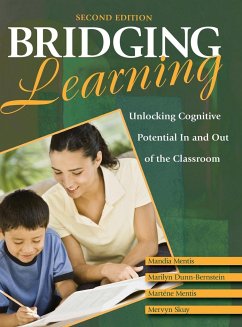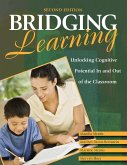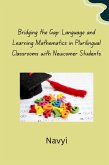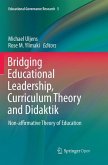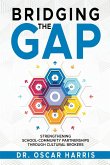- Gebundenes Buch
- Merkliste
- Auf die Merkliste
- Bewerten Bewerten
- Teilen
- Produkt teilen
- Produkterinnerung
- Produkterinnerung
This updated volume provides fourteen core thinking skills that increase students' cognitive capacity and shows educators how to "bridge" these skills to the home and community.
Andere Kunden interessierten sich auch für
![Bridging Learning Bridging Learning]() Mervyn SkuyBridging Learning40,99 €
Mervyn SkuyBridging Learning40,99 €![Bridging the Gap: Language and Learning Mathematics in Plurilingual Classrooms with Newcomer Students Bridging the Gap: Language and Learning Mathematics in Plurilingual Classrooms with Newcomer Students]() NavyiBridging the Gap: Language and Learning Mathematics in Plurilingual Classrooms with Newcomer Students30,23 €
NavyiBridging the Gap: Language and Learning Mathematics in Plurilingual Classrooms with Newcomer Students30,23 €![Greening Media Education Greening Media Education]() Antonio LópezGreening Media Education166,10 €
Antonio LópezGreening Media Education166,10 €![Greening Media Education Greening Media Education]() Antonio LópezGreening Media Education41,85 €
Antonio LópezGreening Media Education41,85 €![Bridging Educational Leadership, Curriculum Theory and Didaktik Bridging Educational Leadership, Curriculum Theory and Didaktik]() Bridging Educational Leadership, Curriculum Theory and Didaktik37,99 €
Bridging Educational Leadership, Curriculum Theory and Didaktik37,99 €![Bridging the Gap Bridging the Gap]() Hank GutierrezBridging the Gap43,99 €
Hank GutierrezBridging the Gap43,99 €![Bridging the Gap Bridging the Gap]() Oscar HarrisBridging the Gap18,99 €
Oscar HarrisBridging the Gap18,99 €-
-
-
This updated volume provides fourteen core thinking skills that increase students' cognitive capacity and shows educators how to "bridge" these skills to the home and community.
Hinweis: Dieser Artikel kann nur an eine deutsche Lieferadresse ausgeliefert werden.
Hinweis: Dieser Artikel kann nur an eine deutsche Lieferadresse ausgeliefert werden.
Produktdetails
- Produktdetails
- Verlag: Corwin
- Artikelnr. des Verlages: B69949C
- 2. Auflage
- Seitenzahl: 152
- Erscheinungstermin: 9. Juni 2009
- Englisch
- Abmessung: 286mm x 221mm x 13mm
- Gewicht: 660g
- ISBN-13: 9781412969949
- ISBN-10: 1412969948
- Artikelnr.: 26219850
- Herstellerkennzeichnung
- Books on Demand GmbH
- In de Tarpen 42
- 22848 Norderstedt
- info@bod.de
- 040 53433511
- Verlag: Corwin
- Artikelnr. des Verlages: B69949C
- 2. Auflage
- Seitenzahl: 152
- Erscheinungstermin: 9. Juni 2009
- Englisch
- Abmessung: 286mm x 221mm x 13mm
- Gewicht: 660g
- ISBN-13: 9781412969949
- ISBN-10: 1412969948
- Artikelnr.: 26219850
- Herstellerkennzeichnung
- Books on Demand GmbH
- In de Tarpen 42
- 22848 Norderstedt
- info@bod.de
- 040 53433511
Mandia Mentis is an educational psychologist and senior lecturer in the Special Education and Educational Psychology Programmes at Massey University, New Zealand. She is an accredited trainer of Instrumental Enrichment (FIE) and the Learning Potential Assessment Device (LPAD), having completed her training at the International Centre for Learning Enhancement in Israel under Reuven Feuerstein. Over the past 20 years, she has run Instrumental Enrichment (FIE) workshops with the Cognitive Research Centre in South Africa and with the Australasian Institute for Learning Enhancement in New Zealand. She has contributed extensively to research projects and publications and has co-written and published two books on Mediated Learning and Instrumental Enrichment. Mentis taught at primary, secondary, and tertiary levels and has worked as an educational psychologist in both special and inclusive education settings. Her teaching and research interests include cognitive assessment, teaching for diversity, and e-learning. Her doctoral research focuses on developing effective e-learning communities of practice.
Preface Acknowledgments About the Authors Introduction 1. Organization Organization: What, Why, When, and Where? Bridging Organization to Formal Learning Concepts Bridging Organization to Informal Learning Concepts Application of Organization: Energy Efforts Feuerstein
s Theory in Mediating Organization 2. Comparisons Comparisons: What, Why, When, and Where? Bridging Comparisons to Formal Learning Contexts Bridging Comparisons to Informal Learning Contexts Application of Comparison: Cyber Counseling Feuerstein
s Theory in Mediating Comparison 3. Categorization Categorization: What, Why, When, and Where? Bridging Categorization to Formal Learning Contexts Bridging Categorization to Informal Learning Contexts Application of Categorization: Toys and Tots Feuerstein
s Theory in Mediating Categorization 4. Relational Orientation in Space Relational Orientation in Space: What, Why, When, and Where? Bridging Relational Orientation in Space to Formal Learning Contexts Bridging Relational Orientation in Space to Informal Learning Contexts Application of Relational Orientation in Space: Family Feuds Feuerstein
s Theory in Mediating Relational Orientation in Space 5. Cardinal Orientation in Space Cardinal Orientation in Space: What, Why, When, and Where? Bridging Cardinal Orientation in Space to Formal Learning Contexts Bridging Cardinal Orientation in Space to Informal Learning Contexts Application of Cardinal Orientation in Space: Cultural Compass Feuerstein
s Theory in Mediating Cardinal Orientation in Space 6. Analysis and Synthesis Analysis and Synthesis: What, Why, When, and Where? Bridging Analysis and Synthesis to Formal Learning Contexts Bridging Analysis and Synthesis to Informal Learning Contexts Application of Analysis and Synthesis: Think Global, Act Local Feuerstein
s Theory in Mediating Analysis and Synthesis 7. Problem Solving Problem Solving: What, Why, When, and Where? Bridging Problem Solving to Formal Learning Contexts Bridging Problem Solving to Informal Learning Contexts Application of Problem Solving: Cyber Bullies and Suicide Scripts Feuerstein
s Theory in Mediating Problem Solving 8. Relationships Relationships: What, Why, When, and Where? Bridging Relationships to Formal Learning Contexts Bridging Relationships to Formal Learning Contexts Application of Relationships: Relatives and Relations Feuerstein
s Theory in Mediating Relationships 9. Temporal Concepts Temporal Concepts: What, Why, When, and Where? Bridging Temporal Concepts to Formal Learning Contexts Bridging Temporal Concepts to Informal Learning Contexts Application of Temporal Concepts: Slow and Steady Feuerstein
s Theory in Mediating Temporal Concepts 10. Instructions Instructions: What, Why, When, and Where? Bridging Instructions to Formal Learning Contexts Bridging Instructions to Informal Learning Contexts Application of Instructions: Implied Instruction Feuerstein
s Theory in Mediating Instructions 11. Progressions Progressions: What, Why, When, and Where? Bridging Progressions to Formal Learning Contexts Bridging Progressions to Informal Learning Contexts Application of Progressions: Cultural Constants and Continuities Feuerstein
s Theory in Mediating Progressions 12. Transitive Relations Transitive Relations: What, Why, When, and Where? Bridging Transitive Relations to Formal Learning Contexts Bridging Transitive Relations to Informal Learning Contexts Application of Transitive Relations: Global Greed Feuerstein
s Theory in Mediating Transitive Relations 13. Syllogisms Syllogisms: What, Why, When, and Where? Bridging Syllogisms to Formal Learning Contexts Bridging Syllogisms to Informal Learning Contexts Application of Syllogisms: Silly Syllogism Feuerstein
s Theory in Mediating Syllogisms 14. Scaffolding Scaffolding: What, Why, When, and Where? Bridging Scaffolding to Formal Learning Contexts Bridging Scaffolding to Informal Learning Contexts Application of Scaffolding: Project Planning Feuerstein
s Theory in Mediating Scaffolding Appendix A: 12 Criteria of a Mediated Learning Experience (MLE) Appendix B: Cognitive Functions and Dysfunctions Appendix C: Cognitive Map Glossary References Index
s Theory in Mediating Organization 2. Comparisons Comparisons: What, Why, When, and Where? Bridging Comparisons to Formal Learning Contexts Bridging Comparisons to Informal Learning Contexts Application of Comparison: Cyber Counseling Feuerstein
s Theory in Mediating Comparison 3. Categorization Categorization: What, Why, When, and Where? Bridging Categorization to Formal Learning Contexts Bridging Categorization to Informal Learning Contexts Application of Categorization: Toys and Tots Feuerstein
s Theory in Mediating Categorization 4. Relational Orientation in Space Relational Orientation in Space: What, Why, When, and Where? Bridging Relational Orientation in Space to Formal Learning Contexts Bridging Relational Orientation in Space to Informal Learning Contexts Application of Relational Orientation in Space: Family Feuds Feuerstein
s Theory in Mediating Relational Orientation in Space 5. Cardinal Orientation in Space Cardinal Orientation in Space: What, Why, When, and Where? Bridging Cardinal Orientation in Space to Formal Learning Contexts Bridging Cardinal Orientation in Space to Informal Learning Contexts Application of Cardinal Orientation in Space: Cultural Compass Feuerstein
s Theory in Mediating Cardinal Orientation in Space 6. Analysis and Synthesis Analysis and Synthesis: What, Why, When, and Where? Bridging Analysis and Synthesis to Formal Learning Contexts Bridging Analysis and Synthesis to Informal Learning Contexts Application of Analysis and Synthesis: Think Global, Act Local Feuerstein
s Theory in Mediating Analysis and Synthesis 7. Problem Solving Problem Solving: What, Why, When, and Where? Bridging Problem Solving to Formal Learning Contexts Bridging Problem Solving to Informal Learning Contexts Application of Problem Solving: Cyber Bullies and Suicide Scripts Feuerstein
s Theory in Mediating Problem Solving 8. Relationships Relationships: What, Why, When, and Where? Bridging Relationships to Formal Learning Contexts Bridging Relationships to Formal Learning Contexts Application of Relationships: Relatives and Relations Feuerstein
s Theory in Mediating Relationships 9. Temporal Concepts Temporal Concepts: What, Why, When, and Where? Bridging Temporal Concepts to Formal Learning Contexts Bridging Temporal Concepts to Informal Learning Contexts Application of Temporal Concepts: Slow and Steady Feuerstein
s Theory in Mediating Temporal Concepts 10. Instructions Instructions: What, Why, When, and Where? Bridging Instructions to Formal Learning Contexts Bridging Instructions to Informal Learning Contexts Application of Instructions: Implied Instruction Feuerstein
s Theory in Mediating Instructions 11. Progressions Progressions: What, Why, When, and Where? Bridging Progressions to Formal Learning Contexts Bridging Progressions to Informal Learning Contexts Application of Progressions: Cultural Constants and Continuities Feuerstein
s Theory in Mediating Progressions 12. Transitive Relations Transitive Relations: What, Why, When, and Where? Bridging Transitive Relations to Formal Learning Contexts Bridging Transitive Relations to Informal Learning Contexts Application of Transitive Relations: Global Greed Feuerstein
s Theory in Mediating Transitive Relations 13. Syllogisms Syllogisms: What, Why, When, and Where? Bridging Syllogisms to Formal Learning Contexts Bridging Syllogisms to Informal Learning Contexts Application of Syllogisms: Silly Syllogism Feuerstein
s Theory in Mediating Syllogisms 14. Scaffolding Scaffolding: What, Why, When, and Where? Bridging Scaffolding to Formal Learning Contexts Bridging Scaffolding to Informal Learning Contexts Application of Scaffolding: Project Planning Feuerstein
s Theory in Mediating Scaffolding Appendix A: 12 Criteria of a Mediated Learning Experience (MLE) Appendix B: Cognitive Functions and Dysfunctions Appendix C: Cognitive Map Glossary References Index
Preface Acknowledgments About the Authors Introduction 1. Organization Organization: What, Why, When, and Where? Bridging Organization to Formal Learning Concepts Bridging Organization to Informal Learning Concepts Application of Organization: Energy Efforts Feuerstein
s Theory in Mediating Organization 2. Comparisons Comparisons: What, Why, When, and Where? Bridging Comparisons to Formal Learning Contexts Bridging Comparisons to Informal Learning Contexts Application of Comparison: Cyber Counseling Feuerstein
s Theory in Mediating Comparison 3. Categorization Categorization: What, Why, When, and Where? Bridging Categorization to Formal Learning Contexts Bridging Categorization to Informal Learning Contexts Application of Categorization: Toys and Tots Feuerstein
s Theory in Mediating Categorization 4. Relational Orientation in Space Relational Orientation in Space: What, Why, When, and Where? Bridging Relational Orientation in Space to Formal Learning Contexts Bridging Relational Orientation in Space to Informal Learning Contexts Application of Relational Orientation in Space: Family Feuds Feuerstein
s Theory in Mediating Relational Orientation in Space 5. Cardinal Orientation in Space Cardinal Orientation in Space: What, Why, When, and Where? Bridging Cardinal Orientation in Space to Formal Learning Contexts Bridging Cardinal Orientation in Space to Informal Learning Contexts Application of Cardinal Orientation in Space: Cultural Compass Feuerstein
s Theory in Mediating Cardinal Orientation in Space 6. Analysis and Synthesis Analysis and Synthesis: What, Why, When, and Where? Bridging Analysis and Synthesis to Formal Learning Contexts Bridging Analysis and Synthesis to Informal Learning Contexts Application of Analysis and Synthesis: Think Global, Act Local Feuerstein
s Theory in Mediating Analysis and Synthesis 7. Problem Solving Problem Solving: What, Why, When, and Where? Bridging Problem Solving to Formal Learning Contexts Bridging Problem Solving to Informal Learning Contexts Application of Problem Solving: Cyber Bullies and Suicide Scripts Feuerstein
s Theory in Mediating Problem Solving 8. Relationships Relationships: What, Why, When, and Where? Bridging Relationships to Formal Learning Contexts Bridging Relationships to Formal Learning Contexts Application of Relationships: Relatives and Relations Feuerstein
s Theory in Mediating Relationships 9. Temporal Concepts Temporal Concepts: What, Why, When, and Where? Bridging Temporal Concepts to Formal Learning Contexts Bridging Temporal Concepts to Informal Learning Contexts Application of Temporal Concepts: Slow and Steady Feuerstein
s Theory in Mediating Temporal Concepts 10. Instructions Instructions: What, Why, When, and Where? Bridging Instructions to Formal Learning Contexts Bridging Instructions to Informal Learning Contexts Application of Instructions: Implied Instruction Feuerstein
s Theory in Mediating Instructions 11. Progressions Progressions: What, Why, When, and Where? Bridging Progressions to Formal Learning Contexts Bridging Progressions to Informal Learning Contexts Application of Progressions: Cultural Constants and Continuities Feuerstein
s Theory in Mediating Progressions 12. Transitive Relations Transitive Relations: What, Why, When, and Where? Bridging Transitive Relations to Formal Learning Contexts Bridging Transitive Relations to Informal Learning Contexts Application of Transitive Relations: Global Greed Feuerstein
s Theory in Mediating Transitive Relations 13. Syllogisms Syllogisms: What, Why, When, and Where? Bridging Syllogisms to Formal Learning Contexts Bridging Syllogisms to Informal Learning Contexts Application of Syllogisms: Silly Syllogism Feuerstein
s Theory in Mediating Syllogisms 14. Scaffolding Scaffolding: What, Why, When, and Where? Bridging Scaffolding to Formal Learning Contexts Bridging Scaffolding to Informal Learning Contexts Application of Scaffolding: Project Planning Feuerstein
s Theory in Mediating Scaffolding Appendix A: 12 Criteria of a Mediated Learning Experience (MLE) Appendix B: Cognitive Functions and Dysfunctions Appendix C: Cognitive Map Glossary References Index
s Theory in Mediating Organization 2. Comparisons Comparisons: What, Why, When, and Where? Bridging Comparisons to Formal Learning Contexts Bridging Comparisons to Informal Learning Contexts Application of Comparison: Cyber Counseling Feuerstein
s Theory in Mediating Comparison 3. Categorization Categorization: What, Why, When, and Where? Bridging Categorization to Formal Learning Contexts Bridging Categorization to Informal Learning Contexts Application of Categorization: Toys and Tots Feuerstein
s Theory in Mediating Categorization 4. Relational Orientation in Space Relational Orientation in Space: What, Why, When, and Where? Bridging Relational Orientation in Space to Formal Learning Contexts Bridging Relational Orientation in Space to Informal Learning Contexts Application of Relational Orientation in Space: Family Feuds Feuerstein
s Theory in Mediating Relational Orientation in Space 5. Cardinal Orientation in Space Cardinal Orientation in Space: What, Why, When, and Where? Bridging Cardinal Orientation in Space to Formal Learning Contexts Bridging Cardinal Orientation in Space to Informal Learning Contexts Application of Cardinal Orientation in Space: Cultural Compass Feuerstein
s Theory in Mediating Cardinal Orientation in Space 6. Analysis and Synthesis Analysis and Synthesis: What, Why, When, and Where? Bridging Analysis and Synthesis to Formal Learning Contexts Bridging Analysis and Synthesis to Informal Learning Contexts Application of Analysis and Synthesis: Think Global, Act Local Feuerstein
s Theory in Mediating Analysis and Synthesis 7. Problem Solving Problem Solving: What, Why, When, and Where? Bridging Problem Solving to Formal Learning Contexts Bridging Problem Solving to Informal Learning Contexts Application of Problem Solving: Cyber Bullies and Suicide Scripts Feuerstein
s Theory in Mediating Problem Solving 8. Relationships Relationships: What, Why, When, and Where? Bridging Relationships to Formal Learning Contexts Bridging Relationships to Formal Learning Contexts Application of Relationships: Relatives and Relations Feuerstein
s Theory in Mediating Relationships 9. Temporal Concepts Temporal Concepts: What, Why, When, and Where? Bridging Temporal Concepts to Formal Learning Contexts Bridging Temporal Concepts to Informal Learning Contexts Application of Temporal Concepts: Slow and Steady Feuerstein
s Theory in Mediating Temporal Concepts 10. Instructions Instructions: What, Why, When, and Where? Bridging Instructions to Formal Learning Contexts Bridging Instructions to Informal Learning Contexts Application of Instructions: Implied Instruction Feuerstein
s Theory in Mediating Instructions 11. Progressions Progressions: What, Why, When, and Where? Bridging Progressions to Formal Learning Contexts Bridging Progressions to Informal Learning Contexts Application of Progressions: Cultural Constants and Continuities Feuerstein
s Theory in Mediating Progressions 12. Transitive Relations Transitive Relations: What, Why, When, and Where? Bridging Transitive Relations to Formal Learning Contexts Bridging Transitive Relations to Informal Learning Contexts Application of Transitive Relations: Global Greed Feuerstein
s Theory in Mediating Transitive Relations 13. Syllogisms Syllogisms: What, Why, When, and Where? Bridging Syllogisms to Formal Learning Contexts Bridging Syllogisms to Informal Learning Contexts Application of Syllogisms: Silly Syllogism Feuerstein
s Theory in Mediating Syllogisms 14. Scaffolding Scaffolding: What, Why, When, and Where? Bridging Scaffolding to Formal Learning Contexts Bridging Scaffolding to Informal Learning Contexts Application of Scaffolding: Project Planning Feuerstein
s Theory in Mediating Scaffolding Appendix A: 12 Criteria of a Mediated Learning Experience (MLE) Appendix B: Cognitive Functions and Dysfunctions Appendix C: Cognitive Map Glossary References Index

